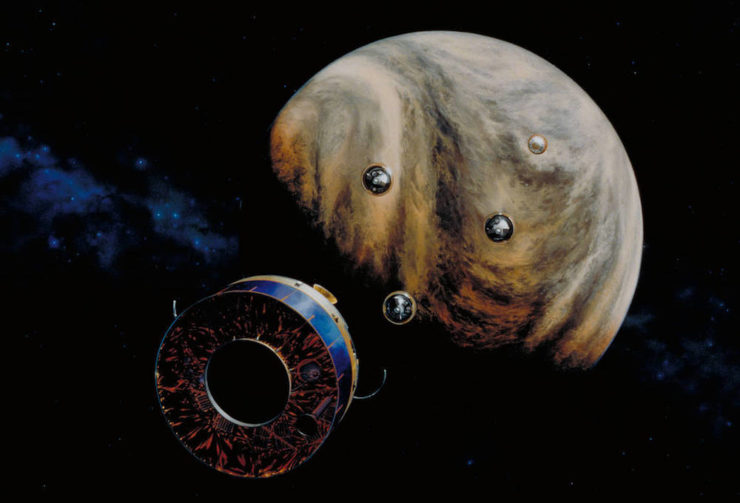Stop me if you’ve heard this before: a Venus covered in a vast ocean, dotted here and there with islands or even continents. A planet that’s a slightly smaller, somewhat warmer version of Earth. Right, you’ve probably read about this Venus in Golden Age SF. Understandably, it was a real bummer for SFF authors when—Science Marches On!—it was revealed that the Venusian atmosphere, close to the surface, is hot enough to melt lead.
But there has been some exciting science news! A recent paper, “A view to the possible habitability of ancient Venus over three billion years,” suggests that Venus might have been habitable as recently as 750 million years ago. Maybe the Venus envisioned by Golden Age SF did exist…just 750 million years too early to do us any good.
There might have been life on Venus. There might even have been Venusians…once. There might even have been intelligent Venusians!
Of course, it’s more likely that Venus never had anything comparable to a newt, let alone a human. If there’s anything the geological record teaches us about life, it’s that planets with life seem pretty comfortable sticking to single-celled life. The current flirtation with complex life is only a bit over half a billion years old. For about 90 percent of Earth’s history, micro-organisms ruled. If Venus had life—if—maybe it was happy little single-celled organisms cheerfully dividing right up to the point the oceans boiled.
But let’s just suppose that there was complex life on the old Venus. Could it have achieved the level of intelligence and technology needed to travel from Venus to Earth? The most recent stab at complex life on Earth has been around for over half a billion years without ever establishing Mars colonies, after all. Even if we limit ourselves to good old humans, it took about two million years to go from Homo Erectus to something potentially able to brew beer, let alone produce rocket fuel. Even after anatomically modern humans appeared, we spent a good thirty times longer faffing about with pointy sticks than we have spent playing with brewing and its related technology.
But just let’s suppose that the hypothetical spacefaring Venusians made it here. (For fun, because this is SF.) How and when this would have happened depends on the timeline we choose for the resurfacing of their native planet. (We assume that they wouldn’t have made it here after the resurfacing was well under way.) 750 million years ago is an estimate with large error bars.
If they arrived during the late Tonian era, which may have ended around 720 million years ago, they would have landed on an Earth that was far from inviting. True, oxygen levels seem to have been slowly rising towards modern values, but the land masses were forbidding wastelands. The single continent, Rodinia, was undergoing dramatic rifting. Earthquakes, volcanoes, tsunamis! Perhaps, like the European colonists in San Miguel de Gualdape, Jamestown, and Fort San Juan, not to mention all but one of the early human species that made the mistake of settling in what is now Britain, local conditions would have been too challenging and the Venusians died out comparatively quickly.
If they arrived after the Tonian era, our alien visitors might have arrived at the start of Cryogenian period. That era was characterized by an ice age more severe than anything humans have ever experienced. Perhaps our probably-didn’t-exist-in-the-first-place neighbours would have been fleeing their planet, preferring freezing to burning up. They could have held on for a while, before the glaciers reached the equator.
We’ll probably never find any relics of such hypothetical colonies. The aftermath of the Cryogenian, the vast melt, scoured away up to a billion years or more of geologic record. Any evidence would have been ground down by massive glaciers and then washed out to sea when they melted. Bother.
Still, if we were hunting for Venusian relics, there is yet one place we could look. The permanently shadowed polar craters of the Moon and the ice therein would have been a tempting resource. Those ice deposits are billions of years old and not at all geologically active. That’s where I’d look for evidence of extra-terrestrial visitors. Well, perhaps the lunar He3 prospectors will find it. (That’s a joke.)
But let’s get back to Venus. What happened there to tip the planet from garden world to hell planet?
I think we can rule out the any possibility that the catastrophe was the fault of the hypothetical Venusians themselves. Their science would have told them clearly that they were sabotaging themselves and of course, no intelligent species would ignore such warnings.
What else might have happened? At the moment, there’s next to no evidence to draw upon. The surface has been thoroughly reworked. Thanks to Venus’ slow rotation, satellites and orbital debris would have long since been dragged down by tidal forces. Working out what happened (perhaps from atmospheric analysis?) would be challenging but still worth the effort. After all, the same thing could happen to us and we don’t have a neighbour anywhere as inviting as Cryogenian Earth.
In the words of Wikipedia editor TexasAndroid, prolific book reviewer and perennial Darwin Award nominee James Davis Nicoll is of “questionable notability.” His work has appeared in Publishers Weekly and Romantic Times as well as on his own websites, James Nicoll Reviews and Young People Read Old SFF (where he is assisted by editor Karen Lofstrom and web person Adrienne L. Travis). He was a finalist for the 2019 Best Fan Writer Hugo Award, and is surprisingly flammable.










